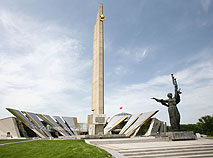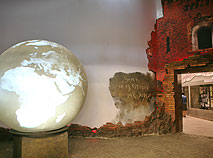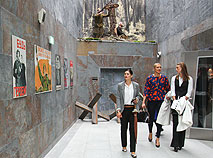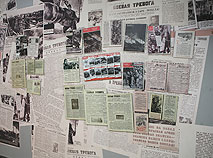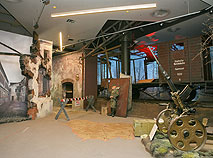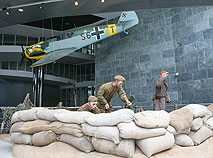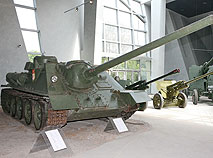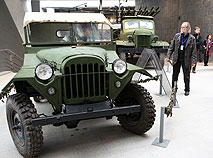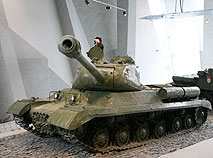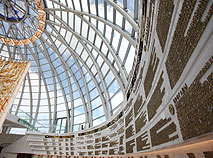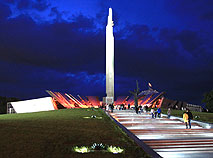Great Patriotic War Museum in Minsk
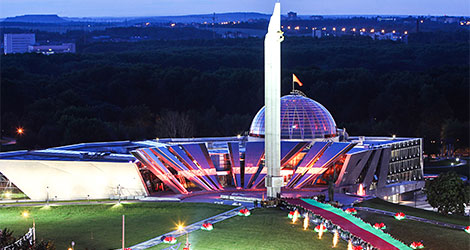
The Belarusian State Museum of the History of the Great Patriotic War was the world’s first museum to tell the story of the bloodiest war of the 20th century, and the only one in Belarus created during the years of Nazi occupation.
Today it is one of the most important and biggest war museums in the world, along with the well-stocked museums in Moscow, Kiev, and New Orleans.
…In those terrible years Belarus lost every third resident. More than 3 million people died, including about 50,000 partisans and underground fighters. Throughout the country there were 250 death camps, including the infamous Trostenets, one of the largest after Auschwitz, Majdanek and Treblinka...
History of the Museum
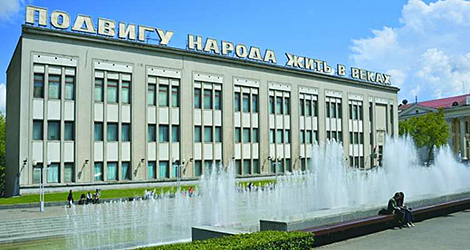
The collection of the world's first museum of the Great Patriotic War was founded in June 1942 when no one could predict how long the war would last...
Future exhibits were sent directly from the frontlines to the special republican commission which was set up to collect the documents and materials about the Great Patriotic War. The commission was working out from Moscow where it was evacuated to during the war. Among the museum’s first assets were the chronicles about the partisan movement, printed and handwritten books, handmade weapons...
For nearly six months there was gap in the frontline near Vitebsk, the so-called Vitebsk Gate. Valuable items, material evidence of the atrocities of the enemy were brought through it to Moscow and were put on display in the State History Museum.
In November 1942 the Muscovites saw an impressive exposition titled as "Belarus lives, Belarus is fighting, Belarus will remain Soviet." It stayed open until August 1944 when it was moved to the liberated Minsk.
The museum, the guardian of the memory about the courage and tragedy of the Belarusian people, was given one of the few intact buildings in the destructed and looted Minsk. It opened to the public on 22 October 1944.
The first expositions about the weapons of the partisans and military print media grew bigger with new rarities. Already in 1944 the museum workers explored the place of the Trostenets death camp. In 1949, they participated in the first excavations in the heroic Brest Fortress...
In 1966, the museum moved to a building specially built for it in the central square of Minsk (now Oktyabrskaya Square). A unique open-air exposition of military equipment and weapons was opened in 1977 next to the museum.
New Museum Building
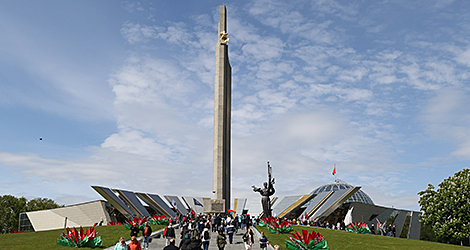
Over decades of research into the Great Patriotic War the museum’s collection has grown many times: even now it gains 700—800 priceless rarities every year.
In the 21st century upon the initiative of the Belarus president plans were made to create new premises for the museum that will boast more exhibition space and modern technologies to tell and demonstrate more facts about the tragic war…
Prominent Belarusians took part in designing the premises, including co-author of the designs of the Minsk railway terminal and the National Library, professor of the International Architecture Academy Viktor Kramarenko, and also Leonid Levin one of the creators of the famous Khatyn Memorial, an Honored Architect of Belarus …
The renewed museum was solemnly opened on 2 July 2014 on the eve of Independence Day and was kind of a tribute to the 70th anniversary of Belarus’ liberation from the Nazi invaders.
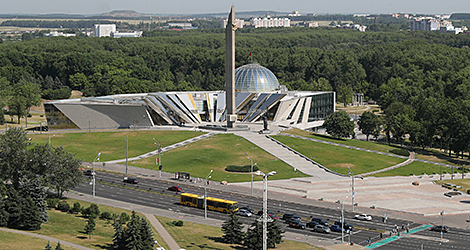
The magnificent building with the total area of 15,600m2 was erected in a significant place of the Belarusian capital – in the Heroes Square next to the stela Minsk - Hero City and the museum and park complex Pobeda. Military parades and festive marches took place nearby – along the Pobeditelei Avenue.
The current premises of the museum are impressive not only due to their scale but also symbolism that reflects major milestones of the history of 1941-1945. The composition represents four main blocks to match the number of years of the war and the army fronts that took part in Belarus’ liberation.
The front facade looks like a festive salute: 11 sparkling rays made of stainless steel to symbolize the Great Victory and at the same time 1,100 tragic days and nights of Minsk’s occupation.
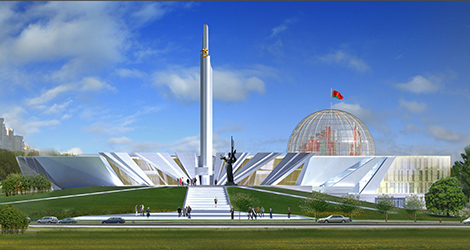
The serious sheen of the metal used for the decoration "speaks" of the war while the golden sparkle of the glass signifies the victory and the greatest treasure that is peace.
The design of the new museum premises gently combines stupendous features and modern technologies. Glass niches are complemented with wide plasma screens. Thanks to laser lights “the rays of the salute” seem to penetrate the night sky underscoring the overall outline of the entire museum premises.
Directly above is a 45-meter stela Minsk – Hero City. It was opened in 1985 for the 40th anniversary of the Great Victory. The sculpture Mother Motherland is located nearby.
The Heroes Square is embellished by a fountain of 170 jets to match the number of Belarusian populated localities that were liberated by the Soviet army during the war.
Exposition
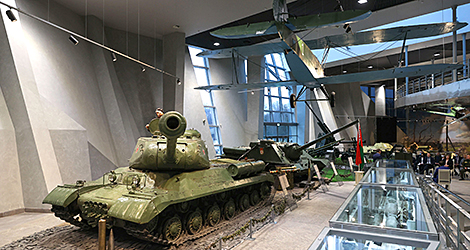
The museum has dedicated over 3,000m2 to over 8,000 exhibits that tell the story of the Great Patriotic War. There are about 145,000 rarities in the museum’s storage. They were collected during military operations in Eastern Europe and Germany and were presented by embassies of various countries in time of peace.
The exhibits are divided into 28 collections and showcased in ten themed halls:
-
World and the war;
-
World before and in the first years of World War II;
-
Road of the war;
-
Beginning of the Great Patriotic War. Defense in Belarus in summer 1941. The battle of Smolensk. The battle of Moscow of 1941-1942;
-
Turning point of the war. The Soviet home front;
-
Nazi occupation regime on the territory of Belarus in 1941-1944;
-
Partisan movement and anti-fascist underground resistance in Belarus. Participation of Soviet people in European resistance movements of 1941-1945;
-
Liberation of Belarus. The defeat of the Nazi Germany, its allies, and the militarist Japan;
-
Belarus after the liberation. The years 1944-1950. Memory of the war;
-
Heirs of the Great Victory.
The most interesting exhibits include:
-
Collection of 27,000 documents (combat reports, orders, diaries, journals of military operations, soldiers’ performance evaluation reports, and others);
Letter of German Sixth Army Commander General Friedrich Paulus of 19 September 1942.
-
Collection of drawings (over 3,000 sketches, cartoons, and mini posters) and paintings (around 500 watercolor and pastel paintings);
-
Flags of military units and partisan detachments;
-
Military uniforms and civilian clothing of the USSR, Germany, Italy, the USA, Czechoslovakia, and France;
-
Personal belongings of famous people born in Belarus (Marshals of the Soviet Union Ivan Yakubovsky, Vasily Sokolovsky, Stepan Krasovsky…);
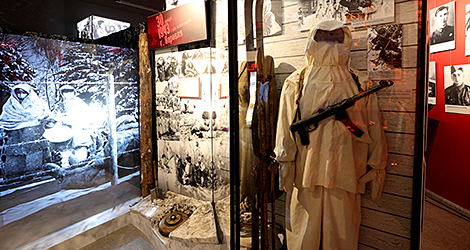
The museum showcases personal items of special-service agent Yelena Mazanik who participated in the operation of Minsk partisans and underground resistance units to kill Commissioner General of the occupied Belarus Wilhelm Kube. Several years after the operation, the story was screened as one of the most famous Soviet movies “The Clock Stopped at Midnight”…
-
Exposition of military vehicles and weapons (T-34 and IS-3 tanks, the famous BM-13 Katyusha multiple rocket launcher, and Li-2 aircraft for military and civil usage);
-
Small arms and artillery weapons.
The multimedia technologies used in the design of expositions include a spherical screen, holographic 3D installations, and a fog screen imitating flame.
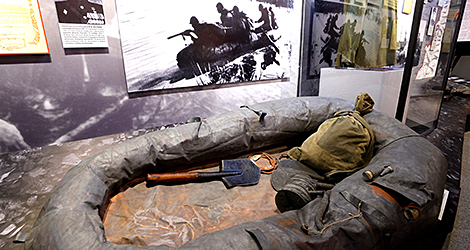
Museum halls are equipped with self-service kiosks where visitors can look through wartime documents, including the correspondence of marshals, German orders, manuscripts and letters of soldiers, lists enumerating the burned villages and prisoners of concentration camps…
Big LCD screens show unique archive footage and more than 40,000 wartime photos.
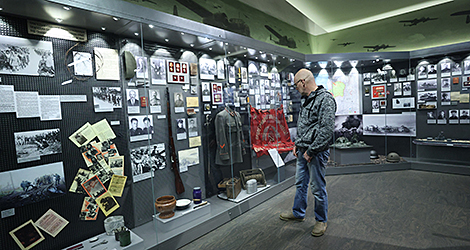
Visitors can take part in the military and historical re-enactments:
-
Tank Ramming;
-
Artillery Section Rafting across the Dnieper River;
-
Air Battle.
All museum halls are united by the biggest hall – the Road of War, which covers about 1,000m2 or one third of the museum’s area. Each level in this hall not only illustrates a certain period of the war but is also reflected in the layout of the Victory Park.
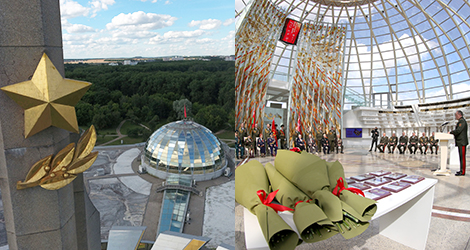
The exposition ends in the magnificent Hall of Victory representing a glass dome of the Reichstag Building where the Soviet soldiers placed the Victory Banner in 1945.
Nowadays the museum is crowned by the Soviet Flag; inside the transparent dome is decorated with a stained-glass panel depicting a stork which is a symbol of Belarus. It offers a breathtaking view of the city, the Svisloch River and the Victory Park.
Excursions to the Museum of the History of the Great Patriotic War
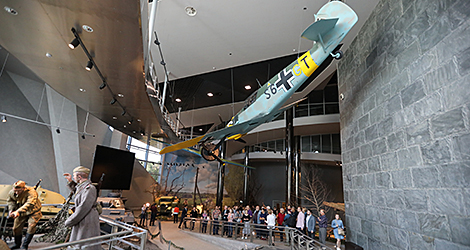
The tickets cost Br13, Br7 for school students.
The museum is open:
-
Tuesday – Sunday from 10:00 to 19:00
Visitors of the museum can book general and thematic tours for groups (up to 25 people). Prices for group tours vary from Br35 to Br50. Apart from that, the museum offers individual consultations; access to the archive, photo and video materials; simulated gun shooting.
Visitors can use audio guides in Russian, Belarusian, English, German, Spanish and Chinese.
How to Find Us
The Museum of the History of the Great Patriotic War is located in the center of Minsk. Address: 8 Pobeditelei Avenue.
You can get to the museum by buses:
-
No. 1, 29, 44, 69, 73, 91, 136, 163 (station Muzey Velikoy Otechestvennoy Voyny).







 print version
print version make home page
make home page add to bookmarks
add to bookmarks